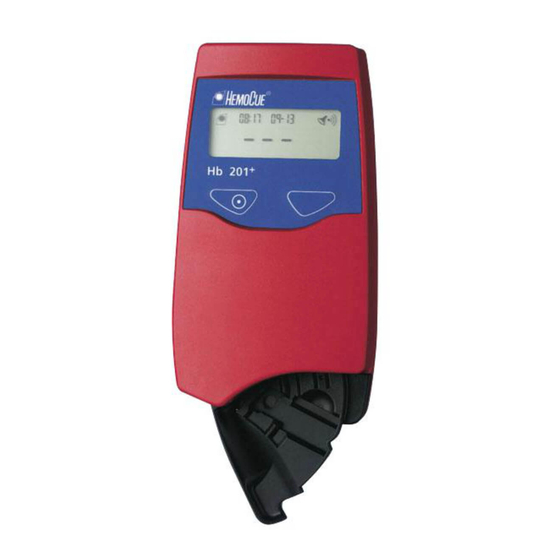
Advertisement
Quick Links
GB/US
HemoCue
Hb 201 Microcuvettes
®
The HemoCue Hb 201 Microcuvettes are designed for use with the HemoCue
Hb 201
Analyzer and the HemoCue Hb 201 DM Analyzer (referred to as the HemoCue
+
Hb 201 Analyzer in this document). HemoCue Hb 201 Microcuvettes are available in
individual packages or in vials. Please read the relevant Operating Manual for proper
use of the system
Intended Purpose/Intended Use
Quantitative determination of hemoglobin in capillary, venous and arterial whole
blood, using a specially designed analyzer, the HemoCue Hb 201 Analyzer, and spe-
cially designed microcuvettes, the HemoCue Hb 201 Microcuvettes. HemoCue Hb 201
Microcuvettes are for In Vitro Diagnostic use only. The HemoCue Hb 201 Analyzer is
only to be used with HemoCue Hb 201 Microcuvettes.
IVD Medical Device Directive
The HemoCue Hb 201 Microcuvettes comply with the IVD Medical Device Direc-
tive 98/79/EC and carry the CE mark
Principles of the method/procedure
Principle of the method
The reaction in the microcuvette is a modified azidemethemoglobin reaction. The
erythrocytes are hemolyzed to release the hemoglobin. The hemoglobin is converted
to methemoglobin and then combined with azide to form azidemethemoglobin. The
measurement takes place in the analyzer in which the transmittance is measured and
the absorbance and hemoglobin level is calculated. The absorbance is directly pro-
portional to the hemoglobin concentration.
Principle of the procedure
The system consists of an analyzer together with microcuvettes. The microcuvette
serves both as a pipette and as a measuring cuvette and is for single-use only. A blood
sample of approximately 10 µL is drawn into the cavity by capillary action. The analyzer
measures at two wavelengths in order to compensate for turbidity, and the hemoglobin
level is calculated and presented. The HemoCue Hb 201 system is calibrated against
the international reference method for hemoglobin determination, ICSH
no further calibration.
Composition
The microcuvette is made of polystyrene plastic. Reagents; <600 μg/g microcuvette
sodium deoxycholate, <300 μg/g microcuvette sodium azide, <300 μg/g microcuvette
sodium nitrite, <350 μg/g microcuvette nonreactive ingredients.
Warning and precautions
The microcuvettes are for In Vitro Diagnostic use only. Always handle blood speci-
mens with care as they may be infectious. Consult local environmental authorities
for proper disposal.
Storage and handling
Use the HemoCue Hb 201 Microcuvettes prior to their expiry date. The expiry date
is printed on each package.
Storage for microcuvettes kept in a vial
The microcuvettes are to be stored at room temperature (15–30 °C, 59–86 °F) and
in a dry place. Once the seal is broken the microcuvettes are stable for three months.
Always keep the vial properly closed.
.
1
and needs
3
Advertisement

Summary of Contents for HemoCue Hb201
- Page 1 HemoCue Hb 201 Analyzer, and spe- cially designed microcuvettes, the HemoCue Hb 201 Microcuvettes. HemoCue Hb 201 Microcuvettes are for In Vitro Diagnostic use only. The HemoCue Hb 201 Analyzer is only to be used with HemoCue Hb 201 Microcuvettes.
- Page 2 • Hydrophobic surface (for venous, arterial or control material samples) Procedure The operating temperature of the HemoCue Hb 201 system is 15-30 °C (59-86 °F). Please read the Operating Manual for proper use of the system . See relevant manu- al for information on repeat capillary sampling.
- Page 3 0.109 0.71 Accuracy The results of the comparison studies between the HemoCue Hb 201 system and the International Council for Standardization in Haematology method (ICSH) are sum- marized in the table below. The study was performed on four HemoCue Hb 201 Analyzer which had not been recalibrated during the study period.
- Page 4 Bibliography 1. HemoCue Hb 201 Operating Manuals 2. Dacie and Lewis, Practical Haemotology, Ninth Edition, 2001. 3. Reference and Selected Procedures for the Quantitative Determination of Hemoglobin in Blood; Approved Standard NCCLS Document H15-A 4. Interference testing in clinical chemistry NCCLS approved guideline; NCCLS Document EP7 5.

Need help?
Do you have a question about the Hb201 and is the answer not in the manual?
Questions and answers